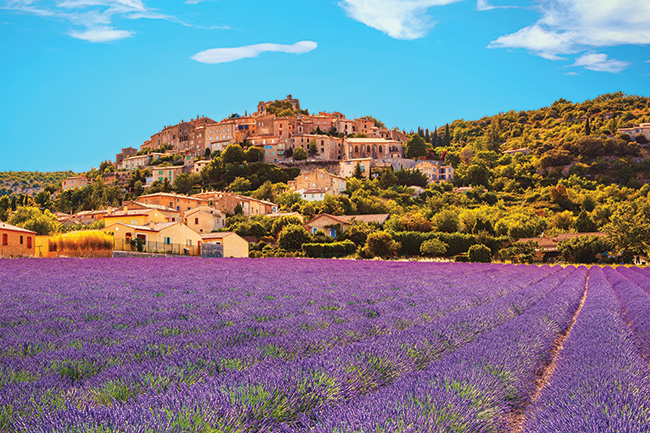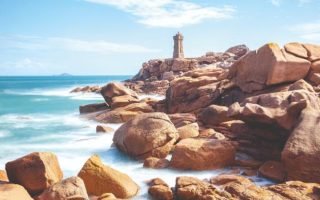Purple Reign: Lavender and Provence
The lavender fields of Provence are among the most iconic sights in France. Jennifer Ladonne hits the road to sniff out the most mesmerising violet vistas and the prettiest of perched villages.
Lavender is to Provence what tulips are to Holland, or cherry blossoms to Japan.
Swathes of the spiked flower’s vividly hued clusters rolling in long iridescent waves to the mountains beyond is indeed a sight to behold. Provence’s lavender routes cover more than 600 miles and the region’s most photogenic scenery and villages, stretching east from the Vaucluse and Luberon to Grasse and the Côte d’Azur, and all the way north to the mountainous upper reaches of the Drôme Provençale.
We’ve broken down the many routes into three essential itineraries that cover the best scenery, villages and lavender-themed activities. You can do all three of these circuits in a week to ten days – or a more enjoyable two weeks, for those with the time. But each circuit could also be covered in a four-day weekend with stops for taking in the scenery and some picnics along the way.

The stunning Valensole plateau © Shutterstock
Things to Know
Lavender and tourism are two of Provence’s biggest industries and during lavender season you’ll be fully immersed in both. The lavender bloom begins in the warmer southern regions in mid-June and unfolds progressively according to altitude, with blooms arriving later in the cooler mountains and peaking throughout July and into August. The harvest begins in mid-July but varies from year to year depending on temperatures and rainfall.
July 14 is la Fête nationale française (Bastille Day to British and Americans), and the beginning of France’s grand départ, when the French drop whatever they’re doing and abandon the cities for more rural regions, more than doubling the traffic in Provence.
The very best time to see the lavender fields is at sunrise or sunset, when there are fewer people, the light is gentle and golden, and temperatures are cooler. The rule in the lavender fields is you can look but don’t touch. This is, after all, someone’s livelihood. Keep in mind before you go that you will need a car. Also keep in mind that everyone else needs one too, and in the most beautiful spots you may find yourself in frustrating lines of traffic.
Crowds thin out a bit in the Drôme Provençale but here you’ll need to take more care as this is the pre-Alps where you’ll be navigating serpentine mountain roads whose astonishing scenery may tempt your eyes away from the road. A big mistake, as on one side, the hairpin curves hide careless drivers until they’re basically at your grille, while the other side is bordered by stone walls and sheer drops. You must also be careful of tourists darting across the road for the perfect Instagram shot. If you’re renting a car be sure you’re adept with a manual transmission or pay a little more for an automatic – you will be glad you did as it makes the steep roads far easier to handle.
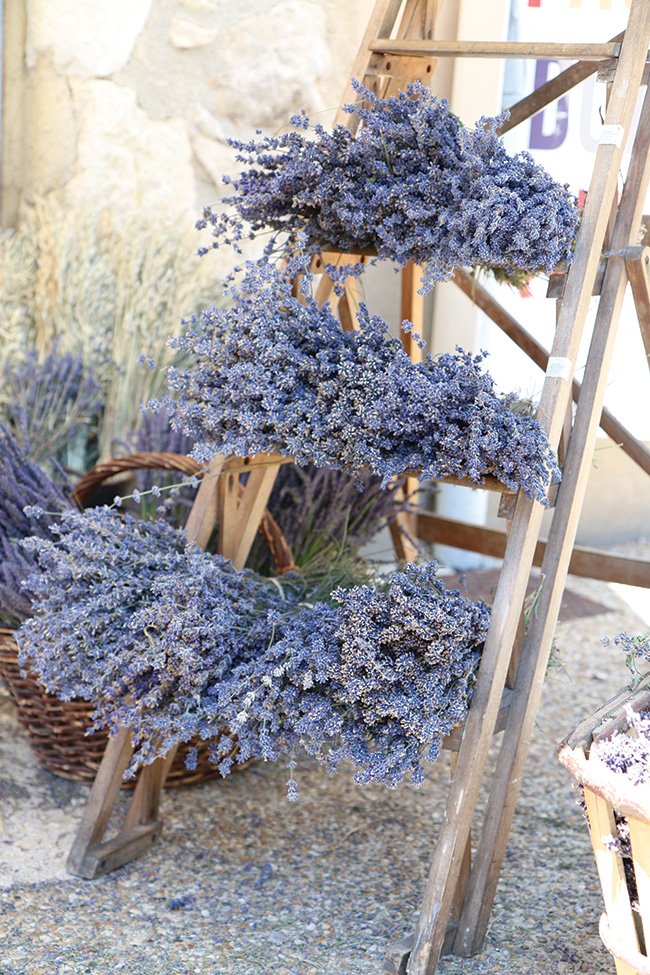
Bunches of lavender Sault © V Gillet VPA
A Lavender Primer
There are scores of lavender varieties but they can be grouped into two basic species: fine (or true) lavender and lavendin, which has grown wild in Provence’s dry rocky soil for centuries. The latter thrives on the lower plains and plateaux under 700 metres (2,300ft) and represents about 90% of the lavender production. The camphorous, less-refined aromas of the essential oil derived from lavendin flowers limits its use to commercial soaps, detergents and the like. Fine lavender is grown above 790 metres (2,600ft) and strict harvesting methods must be adhered to in order to carry the coveted AOP (appellation d’origine contrôlée) designation. AOP oils can be more than 100 times more expensive and are used mostly in fine perfumes and aromatherapy. But you will learn all this and more at the wonderful Musée de la Lavande where we begin our tour.

The Abbey de Sénanque © Shutterstock
The Vaucluse
As the closest point to the Avignon TGV station and car rentals, and a straight shot north from Marseille and its airport, the Vaucluse is a good starting point. The region’s gentle rolling hills and jagged mountain ranges crossed with a patchwork of vineyards, olive groves, lavender fields and postcard-perfect villages – all crowned by the Mont Ventoux – pretty much amount to our dream of Provence. The Musée de la Lavande, in Coustellet, provides a good introduction to how lavender in Provence came to be and acts as a fine springboard into your journey. The museum offers workshops to plumb the depths of the flower, and tours of distilleries and scenery can be booked ahead of time. At its boutique you can stock up on top-quality lavender skincare products.
From here, head straight to Gordes, a Plus Beau Village de France, and the area’s poster-child perched village. If you’re feeling flush, it’s also home to La Bastide de Gordes, Provence’s only palace hotel and one of the great lodgings of France. Wander the town’s cobbled streets – and its scenic farmers’ market if you arrive on a Tuesday morning – before heading to the Abbaye Notre-Dame de Sénanque about 15 minutes away, one of the most photogenic places in Provence, especially when its lavender fields are in bloom. The monks still live and worship at the abbey, one reason it retains its air of serenity despite the tourist hordes. From here, a picturesque (partly single-track) road takes you to Joucas and Lioux, two must-see villages on the way to the medieval village of Saint-Saturninlès- Apt, worth a stop for the views from its windmill, 11th-century chapel and pretty lake. On the route between here and Sault, be sure to stop in at Les Agnels lavender distillery.
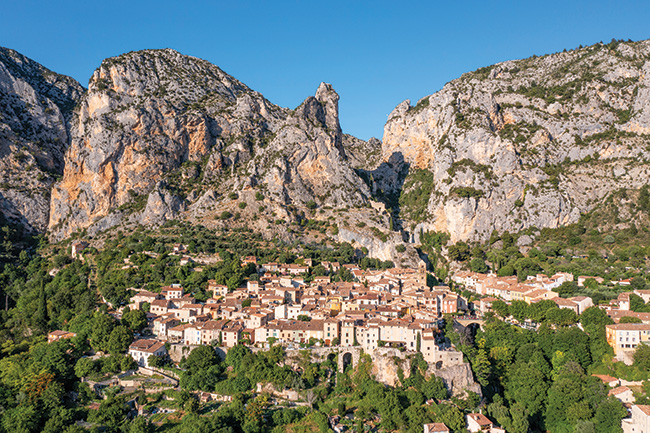
Beautiful Moustiers Sainte Marie © Haute-Provence Pays de Baton Tourisme
The Pays de Sault (pronounced “so”), the Vaucluse’s capital of fine lavender, comprises six small villages – Sault, Aurel, Ferrassières, Monieux, Saint-Christol d’Albion and Saint-Trinit – all of which are worth a visit. At charming Sault, you can stop for lunch and visit the Aroma Plantes distillery to see the process first-hand, then stock up at their boutique. The route from Sault winds up to Ferrassières, then down again to Saint-Christol and to the perched village of Simiane-la-Rotonde, whose diminutive château houses the Société Coopérative Agricole Plantes à Parfum de Provence. The collective represents 300 producers who provide 350 tonnes of essential oils of lavender, lavandin, clary sage, hyssop and tarragon. Along with art exhibitions in its magnifi cent rotunda, the 13th-century château is home to the Sainte-Victoire aromatherapy laboratories shared by the American aromatherapy giant Young Living. Here you’ll learn that lavender oil when diffused can both calm and lift the spirits, help you sleep and cure headaches. Hospitals have found that diffused lavender effectively kills airborne viruses and bacteria, and the oil is also used for relieving burns and arthritis.
At Simiane-la-Rotonde and the lovely lavender-strewn Plateau d’Albion, route D51 forks off to the north towards the Valensole plain (on our third circuit). Here we head south towards beautiful Bonnieux, at the edge of the Luberon valley where the peaks are topped by a high-altitude Atlas Cedar forest, for another kind of sensory experience – and a cluster of lovely villages to explore.
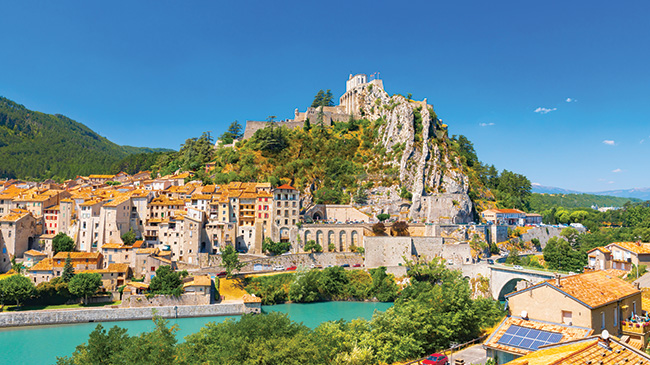
Sisteron is nicknamed “la perle de la Haute-Provence” © Shutterstock
Alpes-de-Haute-Provence
On our second circuit, starting at Simiane-la-Rotonde, we enter the Alpes-de-Haute-Provence region heading toward the Valensole plateau, one of Provence’s most breathtaking regions for lavender-laden vistas. From Simiane-la-Rotonde take the route to Banon, where you must taste the AOC raw goat’s milk Banon cheese aged in a chestnut leaf and neatly tied with raffi a. While here, stop in at Confi serie Leblanc, owned by the founder of L’Occitane, the Provence-based cosmetics chain, who also owns several Provençal speciality food boutiques, including the wonderful Biscuiterie de Forcalquier coming up on our route.
Set between two mountain ranges, the villages of Mane and Forcalquier date back to Roman times. At Mane, the Musée et Jardins de Salagon gives an excellent overview of the area’s rich history and wealth of aromatic and medicinal plants traditionally used in perfume-making. The 12th-century Salagon priory is noted for its architecture and stained glass windows. Forcalquier, once the capital of Haute-Provence, has been a magnet for artists and organic farmers for decades, and its Monday morning market in the town’s main square is the best in the area and a big draw for its many local products, arts and crafts.
From Forcalquier we head into the eastern heart of lavender country as we approach the famous Valensole plateau and Manosque, home to the Provence-based cosmetics and perfume giant L’Occitane en Provence. A pilgrimage to the factory store – with its fabulous boutique, garden and museum where you can spend half a day learning all about Provence’s perfumed history – is a must. Manosque is one of the area’s larger towns and worth stopping in for its medieval ramparts, old town and Romanesque churches. The lavender-strewn plains stretching between Valensole, Brunet and Puimoisson to superb Moustiers-Sainte- Marie – another of the Plus Beaux Villages de France – provide some eye-popping scenery along the Gorges du Verdon.
From here, you can pop over to Sainte-Croix-du-Verdon, a charming village on a rocky ledge jutting over the turquoise lake, with beaches and camping if so inclined. At Gréoux-les-Bains, a short distance away, you can profit from the healing effects of the natural spring waters at the thermal baths.
Drôme Provençale
For the third segment of our tour, hop on the A51 and follow the Durance River out of Provence proper to the Drôme Provençale, where there is so much to see and do you could take a week just scratching the surface of these breathtaking mountainous landscapes.
Entering the Parc naturel régional des Baronnies provençales, we start at Sisteron – called the Pearl of Haute-Provence – for a stroll to its citadel and beautiful views of the river. From here, you can either take the D946 toward Séderon and up to the wild Parc naturel régional du Vercors, or cut over to Montbrun-les-Bains (yet another Plus Beau Village de France) towards Buis-les Baronnies and Nyons. This patch of the Drôme Provençale as you continue up towards the Vercors is a succession of charming postage stamp-sized villages – Mévouillon, Saint-Auban-sur-l’Ouvèze, Laborel, Orpierre, Saint-André-de-Rosans, Rémuzat, La Motte-Chalancon, Chamaloc, all the way up to beautiful Die – interspersed with mountains, rolling purple fields, orchards, olive trees, sunflowers, vineyards and poppies fields as far as the eye can see. At Rémuzat a lovely hike through lavender fields leads to a panoramic lookout point for a glimpse of four species of vultures who make these cliffs their home.

Château de Grignan © La Drome Tourisme
From Crest down to Montbrun-les-Bains be sure to stop in at the villages of Dieulefit (meaning God made it), an ancient pottery town where dozens of ceramicists still ply their trade, and Le Poët-Laval, a beautifully-restored medieval village and historic silk-making town. In Nyons, the bustling heart of the Drôme Provençale, the Thursday morning market (Sundays too in summer) brimming with local specialities and the famous Nyons olives and olive oil, is not to be missed. Or stop in at the Vignolis co-op, where you’ll find every imaginable local product, from handmade cosmetics and essential oils to top-producer olive oil, honey, jam, wine and truffles. They also offer olive oil and olive tastings. Bleu Provence distillery, museum and boutique provides an excellent overview of lavender in the area. Stop in at Nyons tourist office to stock up on everything you’ll need to get the lay of the land ahead of your travels.
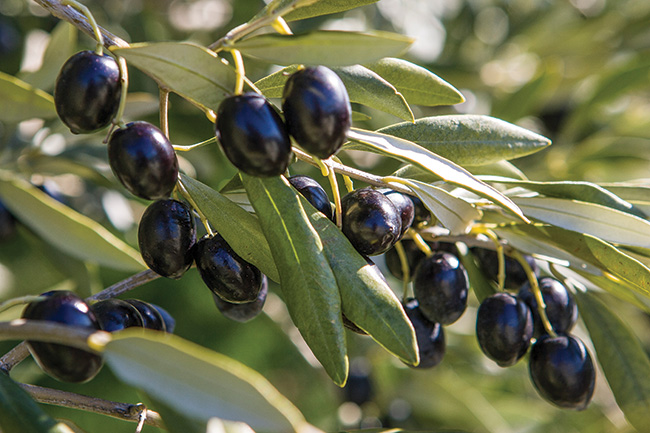
The area around Nyons is famous for its olives © Lionel
Do not miss nearby Grignan, its elegant white-stone silhouette rising up from lavender, poppy and sunflower fields and topped by a beautifully restored Renaissance château (where Madame Sévégné visited her beloved daughter and wrote her letters). While in Grignan, a table at the Café des Vignerons will afford you a taste of the local specialities and wines.
Historic, antique-filled Le Clair de la Plume hotel at the entryway to the town is among the most charming hotels in Provence, with a Michelin-starred restaurant to boot. Even if you don’t stay here, a meal in their Provençal gardens is a must.
From France Today magazine
Lead photo credit : Simiane-la-Rotonde is in the heart of lavender country © Shutterstock
Share to: Facebook Twitter LinkedIn Email
More in beautiful villages, chateaux, French beauty, French culture, French nature, French skincare, lavender, Provence
Leave a reply
Your email address will not be published. Required fields are marked *

